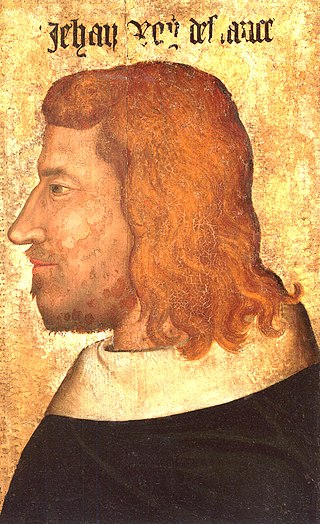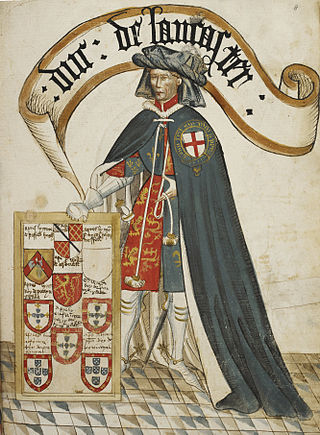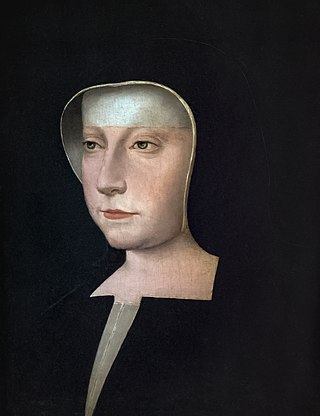Year 1373 (MCCCLXXIII) was a common year starting on Saturday of the Julian calendar.

Henry IV, also known by the epithets Good King Henry or Henry the Great, was King of Navarre from 1572 and King of France from 1589 to 1610. He was the first monarch of France from the House of Bourbon, a cadet branch of the Capetian dynasty. He was assassinated in 1610 by François Ravaillac, a Catholic zealot, and was succeeded by his son Louis XIII.

Charles II, called Charles the Bad, was King of Navarre 1349–1387 and Count of Évreux 1343–1387.

Charles V, called the Wise, was King of France from 1364 to his death in 1380. His reign marked an early high point for France during the Hundred Years' War, with his armies recovering much of the territory held by the English, and successfully reversed the military losses of his predecessors.

John II, called John the Good, was King of France from 1350 until his death in 1364. When he came to power, France faced several disasters: the Black Death, which killed nearly 40% of its population; popular revolts known as Jacqueries; free companies of routiers who plundered the country; and English aggression that resulted in catastrophic military losses, including the Battle of Poitiers of 1356, in which John was captured.

Charles IV, called the Fair in France and the Bald in Navarre, was last king of the direct line of the House of Capet, King of France and King of Navarre from 1322 to 1328. Charles was the third son of Philip IV; like his father, he was known as "the fair" or "the handsome".

The French Wars of Religion is the term which is used in reference to a period of civil war between French Catholics and Protestants, commonly called Huguenots, which lasted from 1562 to 1598. According to estimates, between two and four million people died from violence, famine or diseases which were directly caused by the conflict; additionally, the conflict severely damaged the power of the French monarchy. The fighting ended in 1598 when Henry of Navarre, who had converted to Catholicism in 1593, was proclaimed Henry IV of France and issued the Edict of Nantes, which granted substantial rights and freedoms to the Huguenots. However, Catholics continued to have a hostile opinion of Protestants in general and of Henry, and his assassination in 1610 triggered a fresh round of Huguenot rebellions in the 1620s.

Charles III, called the Noble, was King of Navarre from 1387 to his death and Count of Évreux in France from 1387 to 1404, when he exchanged Évreux for the Duchy of Nemours.

Peter I of Bourbon was the second Duke of Bourbon, from 1342 to his death. Peter was son of Louis I of Bourbon, whom he also succeeded as Grand Chamberlain of France, and Mary of Avesnes.

Henry of Grosmont, Duke of Lancaster was an English statesman, diplomat, soldier, and Christian writer. The owner of Bolingbroke Castle in Lincolnshire, Grosmont was a member of the House of Plantagenet, which was ruling over England at that time. He was the wealthiest and most powerful peer of the realm.

Louise of Savoy was a French noble and regent, Duchess suo jure of Auvergne and Bourbon, Duchess of Nemours and the mother of King Francis I and Marguerite of Navarre. She was politically active and served as the regent of France in 1515, in 1525–1526 and in 1529.

Blanche II, was the titular Queen of Navarre between 1461 and 1464. She was the daughter of John II of Aragon and Blanche I of Navarre. She was also Princess of Asturias by marriage to Henry of Castile.

Robert le Coq was a French bishop and councillor.

The Italian War of 1521–1526, sometimes known as the Four Years' War, was a part of the Italian Wars. The war pitted Francis I of France and the Republic of Venice against the Holy Roman Emperor Charles V, Henry VIII of England, and the Papal States. It arose from animosity over the election of Charles as Emperor in 1519–1520 and from Pope Leo X's need to ally with Charles against Martin Luther.
The Treaty of Valognes was a treaty signed on 10 September 1355 between Charles II of Navarre and John II of France. It was designed to unite the two kings against Edward III of England in preparation for a continuation of the Hundred Years' War. Charles and John had until then been at odds over Charles' claim to the French throne.
Philip of Navarre, Count of Longueville (1336–1363) was a younger brother and supporter of Charles II of Navarre, a claimant to the French throne. The son of Philip III of Navarre and Joan II of Navarre, he married Yolande of Flanders in 1353. She was the daughter of Robert of Flanders and Joan of Brittany and the widow of Henry IV of Bar. The marriage was childless, though by his mistress Jeannette d'Aisy Philip had two illegitimate children - Lancelot and Robine. Philip and his brother Charles fought against John II of France in 1353.

The Auld Alliance was an alliance between the kingdoms of Scotland and France against England made in 1295. The Scots word auld, meaning old, has become a partly affectionate term for the long-lasting association between the two countries. Although the alliance was never formally revoked, it is considered by some to have ended with the signing of the Treaty of Edinburgh in 1560.
The Truce of Calais was a truce agreed by King Edward III of England and King Philip VI of France on 28 September 1347, which was mediated by emissaries of Pope Clement VI. The Hundred Years' War had broken out in 1337 and in 1346 Edward had landed with an army in northern France. After inflicting a heavy defeat on Philip and a French army at the Battle of Crécy the English besieged Calais, which fell after 11 months. Both countries were financially and militarily exhausted and two cardinals acting for Pope Clement were able to broker a truce in a series of negotiations outside Calais. This was signed on 28 September to run until 7 July 1348.
Lancaster's chevauchée of 1356 in Normandy was an English offensive directed by Henry, Duke of Lancaster, in northern France during 1356, as a part of the Hundred Years' War. The offensive took the form of a large mounted raid – a chevauchée – and lasted from 22 June to 13 July. During its final week the English were pursued by a much larger French army under King John II that failed to force them to battle.
The Treaty of Guînes was a draft settlement to end the Hundred Years' War, negotiated between England and France and signed at Guînes on 6 April 1354. The war had broken out in 1337 and was further aggravated in 1340 when the English king, Edward III, claimed the French throne. The war went badly for France: the French army was heavily defeated at the Battle of Crécy, and the French town of Calais was besieged and captured. With both sides exhausted, a truce was agreed that, despite being only fitfully observed, was repeatedly renewed.













